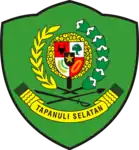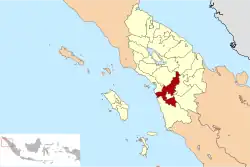South Tapanuli Regency
(Kabupaten Tapanuli Selatan) | |
|---|---|
_(01).jpg.webp) Welcome gate to South Tapanuli Regency | |
 Coat of arms | |
 Location of South Tapanuli in North Sumatra | |
| Country | Indonesia |
| Province | North Sumatra |
| Regency seat | Sipirok |
| Government | |
| • Regent | Dolly Parlindungan Putra Pasaribu, S.Pt., M.M. |
| • Vice Regent | Rasyid Asyraf Dongoran, S.Si., M.Si. |
| • Chairman of Regency's Council of Representatives | Husin Sogot Simatupang (Gerindra) |
| • Vice Chairmen of Regency's Council of Representatives | Rahmad Nasution (Golkar) and Borkat (National Mandate Party) |
| Area | |
| • Total | 6,030.47 km2 (2,328.38 sq mi) |
| Population (mid 2022 estimate)[1] | |
| • Total | 317,080 |
| • Density | 53/km2 (140/sq mi) |
| Time zone | UTC+7 (WIB) |
| Website | www |
South Tapanuli (Tapanuli Selatan in Indonesian Language, abbreviated Tapsel) is a regency in North Sumatra, Indonesia. Its seat is the town of Sipirok. This regency was originally very large and contained thousands of towns and villages, including the city of Padang Sidempuan. The areas that have separated from South Tapanuli Regency are the new regencies of Mandailing Natal (created on 23 November 1998), Padang Lawas Utara and Padang Lawas (both created on 17 July 2007), all lying to the south-east of the residual South Tapanuli Regency, plus the city (kota) of Padang Sidempuan (created on 21 June 2001). After the division, the regency seat moved to from Padang Sidempuan to Sipirok.
The regency covers an area of 4,355.35 square kilometers and had a population of 264,108 at the 2010 census[2] and 300,911 at the 2020 Census;[3] the official estimate as at mid 2022 was 317,080.[1] These figures exclude the city of Padang Sidempuan, which is virtually surrounded by South Tananuli territory but is independently administered.
There are several attractions in the regency, including Lake Marsabut and Lake Siais. The language used by the people is the Angkola Batak language. The majority religion of the population is Islam. An airport is located at Aek Godang in Hulu Sihapas District, North Padang Lawas Regency.
Administration
At the 2010 Census, the regency was divided into twelve districts (kecamatan). Subsequently, three additional districts (Tano Tombangan Angkola, Angkola Muara Tais and Angkola Sangkunur) have been created by the division of existing districts. The districts are tabulated below with their areas and their populations at the 2010 Census[2] and 2020 Census,[3] together with the official estimates as at mid 2022.[1] The table also includes the locations of the district administrative centres, the number of administrative villages in each district (totaling 211 rural desa and 37 urban kelurahan), and its post code.
| Kode Wilayah | Name of District (kecamatan) | Area in km2 | Pop'n Census 2010 | Pop'n Census 2020 | Pop'n Estimate mid 2022 | Admin centre | No. of desa | No. of kelurahan | Post code |
|---|---|---|---|---|---|---|---|---|---|
| 12.03.07 | Batang Angkola | 211.36 | 32,129 | 21,323 | 21,568 | Pintu Padang | 17 | 4 | 22773 |
| 12.03.21 | Sayur Matinggi | 295.11 | 37,655 | 26,014 | 26,454 | Sayur Matinggi | 18 | 1 | 22774 |
| 12.03.30 | Tano Tombangan Angkola | 210.30 | (a) | 15,548 | 15,704 | Situmba | 16 | 1 | 22775 |
| 12.03.32 | Angkola Muara Tais | 149.70 | (b) | 13,766 | 13,950 | Muara Tais | 13 | 2 | 22733 |
| 12.03.03 | Angkola Timur (East Angkola) | 235.16 | 18,553 | 21,294 | 21,763 | Pargarutan | 13 | 2 | 22733 |
| 12.03.06 | Angkola Selatan (South Angkola) | 496.57 | 27,500 | 32,757 | 33,919 | Simarpinggan | 13 | 4 | 22732 |
| 12.03.01 | Angkola Barat (West Angkola) | 104.52 | 41,254 | 25,206 | 25,308 | Sitinjak | 12 | 2 | 22735 |
| 12.03.31 | Angkola Sangkunur | 254.77 | (c) | 21,740 | 22,436 | Simataniari | 8 | 2 | 22734 |
| 12.03.02 | Batang Toru | 380.04 | 28,595 | 33,760 | 34,692 | Batang Toru | 19 | 4 | 22738 |
| 12.03.20 | Marancar | 89.11 | 9,351 | 10,359 | 10,515 | Pasar Sempurna | 11 | 1 | 22737 |
| 12.03.29 | Muara Batang Toru | 308.01 | 11,401 | 15,806 | 16,755 | Huta Raja | 6 | 3 | 22736 |
| 12.03.04 | Sipirok | 409.37 | 30,435 | 33,326 | 33,751 | Sipirok | 34 | 6 | 22739 |
| 12.03.14 | Arse | 265.90 | 7,872 | 8,677 | 8,799 | Arse Nauli | 8 | 2 | 22748 |
| 12.03.05 | Saipar Dolok Hole | 540.57 | 12,674 | 13,940 | 14,130 | Sipagimbar | 12 | 2 | 22759 |
| 12.03.22 | Aek Bilah | 404.85 | 6,396 | 7,395 | 7,568 | Biru | 12 | - | 22758 |
| Totals | 4,355.35 | 263,815 | 300,911 | 307,312 | Sipirok | 211 | 37 | ||
Notes:
(a) the 2010 population of the new Tano Tombangan Angkola District is included in the figure for Sayur Matinggi District, from which it was split off.
(b) the 2010 population of the new Angkola Muara Tais District is included in the figure for Batang Angkola District, from which it was split off.
(c) the 2010 population of the new Angkola Sangkunur District is included in the figure for Angkola Barat District, from which it was split off.
Geography
Location
To the north, the district is bordered by the Central Tapanuli Regency and North Tapanuli Regency. The regency borders the Padang Lawas Regency in the east, and to the north, the west and the south it borders the Mandailing Natal Regency. In the middle of the South Tananuli Regency is Padang Sidimpuan City, which is entirely surrounded by this Regency.
Sights
_Jul2013_01.JPG.webp)
Sights include a waterfall in Damparan Hauntas, in Saipar Dolok Hole District.
Archaeology
The Padang Lawas archaeological site is partly located in the regency. The site covers approximately 1,500 km² in this regency and in the Padang Lawas and North Padang Lawas regencies.
Wildlife
The critically endangered Tapanuli orangutan lives in the region. It was described as a distinct species in 2017 and represents the first extant species of great ape to be described since the bonobo in 1929.[4] Scientists identify new species of great ape, Pongo tapanuliensis or Tapanuli orangutan, but fear its survival is already in doubt as habitat under threat.[5]
References
- 1 2 3 Badan Pusat Statistik, Jakarta, 2023, Kabupaten Tapanuli Selatan Dalam Angka 2023 (Katalog-BPS 1102001.1203)
- 1 2 Biro Pusat Statistik, Jakarta, 2011.
- 1 2 Badan Pusat Statistik, Jakarta, 2021.
- ↑ Reese, April (2017). "Newly discovered orangutan species is also the most endangered". Nature. 551 (7679): 151. doi:10.1038/nature.2017.22934. PMID 29120449.
- ↑ Guardian, Guardian (2 November 2017). "New species of orangutan discovered in Sumatra – and is already endangered". the Guardian. Retrieved 30 November 2022.
Sources
- Simanjuntak, Truman, M. Hisyam, Bagyo Prasetyo, Titi Surti Nastiti (éds.), Archaeology: Indonesian perspective : R.P. Soejono's festschrift, LIPI, Jakarta, 2006, ISBN 979-26-2499-6
